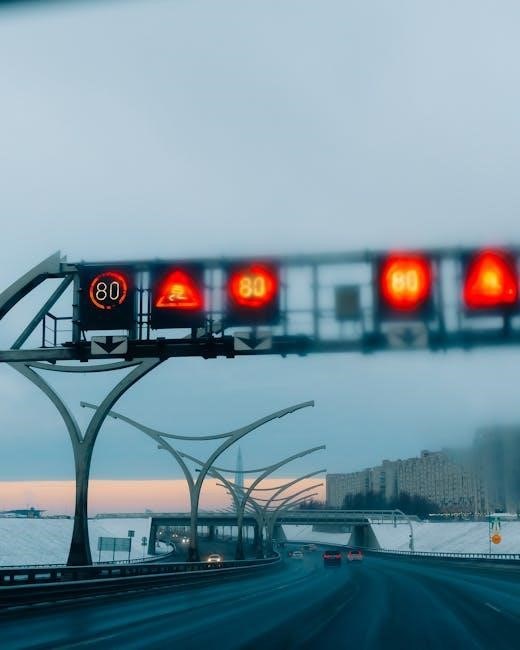Highway and expressway guide signs are informational signs that assist drivers in navigating complex road networks. Their primary function is to provide essential information about destinations, routes, distances, exits, and services. These signs help drivers make informed decisions, ensuring safe and efficient travel. Route signs and auxiliary signs showing junctions and turns are crucial for guidance on approach roads, route confirmation, and reassurance along the freeway or expressway.
1.1 Definition and Purpose
Highway and expressway guide signs are informational signs designed to assist drivers in navigating road networks efficiently. Their primary purpose is to provide clear and concise information about destinations, routes, distances, exits, and services. These signs are essential for helping drivers make informed decisions, ensuring safe and efficient travel. They are typically placed at strategic locations, such as intersections, exits, and along highways, to guide motorists seamlessly. Guide signs include route markers, directional indicators, and service notifications, all aimed at reducing confusion and enhancing navigation. By providing critical information, these signs play a vital role in maintaining smooth traffic flow and promoting safe driving practices.
1.2 Importance of Guide Signs for Navigation
Guide signs are crucial for effective navigation on highways and expressways, providing drivers with essential information to make informed decisions. They help reduce confusion by clearly indicating destinations, routes, and services, ensuring motorists stay on course. These signs are strategically placed at intersections, exits, and along roadways to guide drivers seamlessly. By offering advance notice of exits, junctions, and points of interest, guide signs enhance safety and efficiency. They also assist in maintaining smooth traffic flow, reducing the need for sudden maneuvers. Clear and consistent signage is vital for promoting safe driving practices, especially in unfamiliar areas. Guide signs are indispensable for navigating complex road networks confidently.

Types of Highway and Expressway Guide Signs
Highway and expressway guide signs include route signs, directional signs, service signs, auxiliary signs, and junction signs, providing essential information about destinations, routes, distances, exits, and services.
2.1 Route Signs

Route signs are essential for identifying specific highways and routes, helping drivers navigate efficiently. These signs typically display route numbers, names, or destinations, often accompanied by directional arrows. They are strategically placed at key locations such as approach roads, entrances, and exits to provide clear guidance. Route signs are designed to be highly visible, with enlarged text and standardized colors for legibility. For example, interstate route signs are shield-shaped and blue, while U.S. highways use black-and-white signs. These signs reassure drivers they are on the correct route and help them prepare for upcoming junctions or exits. Their consistent design ensures clarity, making them indispensable for safe and efficient travel.
2.2 Directional Signs
Directional signs guide drivers toward specific destinations, such as cities, towns, or points of interest. These signs are typically placed at key decision points, like exits or intersections, to help drivers choose the correct path. They often feature arrows indicating the direction of travel and may include distances to destinations. Directional signs are designed to be easily readable at high speeds, with clear typography and contrasting colors, such as green backgrounds with white text. They play a crucial role in reducing driver confusion and enhancing traffic flow by providing timely and accurate guidance. By following directional signs, drivers can navigate complex road networks with confidence and efficiency.
2.3 Service Signs
Service signs provide drivers with information about essential amenities and services near the highway or expressway. These signs typically indicate the location of gas stations, restaurants, hotels, hospitals, and rest areas. They are designed to help travelers find necessary services without disrupting the flow of traffic. Service signs are usually blue with white text and symbols, making them easily recognizable. They are strategically placed near exits or interchanges to guide drivers to nearby facilities. By offering clear and concise information, service signs enhance the driving experience, ensuring that travelers can access basic needs while on the road. This helps reduce distractions and keeps traffic moving smoothly.
2.4 Auxiliary Signs
Auxiliary signs provide additional information to support navigation and traffic flow. These signs often include junction signs, turn signs, and lane-use signs, which help drivers prepare for upcoming maneuvers. Auxiliary signs are placed before interchanges or key decision points to guide drivers through complex road layouts. They may feature arrows, diagrams, or text to indicate lane changes, merges, or diverges. These signs are crucial for maintaining traffic order and reducing congestion. By clearly indicating what actions drivers should take, auxiliary signs enhance safety and efficiency on highways and expressways. Their design often includes bold graphics and clear instructions to ensure visibility and understanding, making them indispensable for smooth traffic management.
2.5 Junction and Turn Signs
Junction and turn signs are essential for guiding drivers through complex interchanges and directional changes. These signs provide clear instructions about upcoming turns, lane shifts, or merges. They often feature arrows, diagrams, or text to indicate the correct path or action. Junction signs may show a simplified graphic view of the exit arrangement, helping drivers understand the layout ahead. Turn signs are used to direct traffic toward specific routes or exits. Both types of signs are critical for maintaining smooth traffic flow and reducing confusion at critical decision points. Their design emphasizes clarity and visibility, ensuring drivers can react safely and efficiently to changing road conditions.
Design and Standardization of Guide Signs
Highway and expressway guide signs are designed with standardized color schemes, typography, and graphic elements to ensure clarity and consistency, aiding driver navigation effectively, as per MUTCD guidelines.
3.1 Color Schemes and Legibility
Highway and expressway guide signs utilize standardized color schemes to enhance legibility and visibility. Green backgrounds with white text are commonly used for guide signs, ensuring readability at high speeds. The Manual on Uniform Traffic Control Devices (MUTCD) specifies these color standards to maintain consistency nationwide. High-contrast colors help drivers quickly recognize and understand the information, reducing confusion. Legibility is further enhanced through large, clear typography and minimal clutter. Reflective materials are often used to improve visibility at night or in low-light conditions. These design elements work together to ensure that guide signs are easily readable, even from a distance, promoting safe and efficient navigation for all drivers.
3.2 Typography and Readability

Typography plays a critical role in the readability of highway and expressway guide signs. The Manual on Uniform Traffic Control Devices (MUTCD) specifies standardized fonts, such as the FHWA Series, to ensure consistency and clarity. These fonts are designed to be highly legible at high speeds and from a distance. Clearview, a font developed for highway signs, is widely used due to its readability under various lighting conditions. Proper spacing, font size, and letter height are carefully calibrated to minimize eye strain and ensure quick comprehension. The typography is optimized to reduce driver confusion, allowing motorists to process information efficiently while maintaining focus on the road. This attention to detail enhances overall safety and navigation effectiveness.
3.3 Graphic Elements and Symbols
Graphic elements and symbols on highway and expressway guide signs are essential for quick comprehension. These visuals, such as arrows, route markers, and service symbols, are standardized to ensure universal recognition. The Manual on Uniform Traffic Control Devices (MUTCD) dictates the design of these elements to maintain consistency nationwide. Symbols are often simplified to be easily understood at a glance, even by non-English speakers. Color-coded graphics, like green backgrounds for guide signs, enhance readability. Arrows indicate directions, while pictograms represent services like food or lodging. These elements work together to convey complex information efficiently, reducing driver confusion and ensuring safe navigation. Their clarity is crucial for motorists traveling at high speeds.
Placement and Visibility of Guide Signs

Guide signs are strategically placed to ensure visibility and clarity. Advance guide signs appear before exits, while exit signs display clear destinations. Reassurance signs confirm routes after interchanges, helping drivers stay informed and navigate safely.
4.1 Advance Guide Signs
Advance guide signs are placed before exits or key decision points to provide essential information. They display destinations, distances, and directions, helping drivers prepare for upcoming turns or exits. These signs are crucial for safe navigation, as they allow drivers to make informed decisions without last-minute maneuvers. Advance signs are typically larger and more detailed than standard signs, ensuring visibility even at high speeds. They often include arrows, route numbers, and distance measurements to guide drivers effectively. Proper placement of advance signs ensures that drivers have ample time to react, enhancing traffic flow and reducing congestion. Their clear design and strategic positioning make them indispensable for efficient highway travel.
4.2 Exit and Destination Signs
Exit and destination signs are critical for guiding drivers to their desired routes or points of interest. These signs are typically placed near exits or intersections, providing clear information about upcoming destinations. They often include the name of the exit, the destination city or landmark, and directional arrows to indicate the path. Exit signs are usually green with white lettering, making them highly visible. They help drivers identify exits and make informed decisions about their route. Destination signs may also include distance information, assisting drivers in planning their journey. By clearly indicating exits and destinations, these signs reduce confusion and enhance navigation, ensuring drivers reach their intended locations safely and efficiently.
4.3 Reassurance Signs
Reassurance signs are essential for confirming route information and reducing driver uncertainty. These signs are placed at regular intervals along highways and expressways to remind drivers of their current route or direction. They often feature route numbers, shields, and sometimes destination names, providing confidence that the driver is on the correct path. Reassurance signs are typically green with white lettering, ensuring high visibility. They are especially important on long stretches of road where exits or intersections are infrequent. By reinforcing route information, these signs help maintain driver confidence, reduce anxiety, and enhance overall navigation. Their strategic placement contributes to smoother traffic flow and a safer driving experience. Reassurance signs are a vital component of the guide sign system, ensuring drivers stay informed and oriented throughout their journey.

Regional Variations in Guide Signs
Regional variations in guide signs reflect differences in design, color schemes, and specific information across Interstate, U.S., and State Highways, aiding navigation while maintaining clarity.
5.1 Interstate Highways
Interstate Highways are part of the federal highway system, with guide signs featuring a distinctive red, white, and blue shield design. These signs are standardized nationwide, ensuring consistency in navigation. They display route numbers, often with directional prefixes like “North” or “South,” and are prominently placed for visibility. Interstate guide signs typically include destinations, exit numbers, and mileage, aiding long-distance travelers. Their design emphasizes clarity and uniformity, making them easily recognizable across state lines. This consistency helps drivers navigate seamlessly, regardless of regional variations in other highway systems. The shield symbol is a key identifier, reinforcing the Interstate Highway System’s federal designation and importance in the national transportation network.
5.2 U.S. Highways
U.S. Highways are part of the federal highway system, with guide signs typically featuring a black and white shield design. These signs provide essential information for travelers, including route numbers, destinations, and directional guidance. U.S. Highways often connect cities and towns, serving as key routes for regional travel. Their guide signs may include directional prefixes like “North” or “South” to indicate the route’s direction. While similar to Interstate Highways in functionality, U.S. Highways have distinct design elements, such as a different shield shape and color scheme. These signs are standardized to ensure clarity and consistency, helping drivers navigate efficiently across state lines. They play a vital role in the national transportation network, complementing Interstate Highways while serving unique regional needs.
5.3 State Highways
State Highways are routes designated and maintained by individual states, with guide signs tailored to regional navigation needs. These signs typically feature a unique design, often incorporating state-specific colors or symbols. For example, some states use a circular or triangular shape for their highway markers, while others employ distinctive color schemes. State Highway guide signs provide essential information for travelers, such as route numbers, destinations, and directional guidance. They are particularly important for connecting local communities and attractions, serving as vital links within a state’s transportation network. While their design may vary, the primary goal remains consistent: to ensure clear and efficient navigation for drivers. State Highways often complement Interstate and U.S. Highways, offering alternative routes and access to regional points of interest.

The Role of Guide Signs in Safe Driving
Guide signs play a crucial role in safe driving by providing clear directions, reducing driver confusion, and enhancing traffic flow. They ensure informed decision-making, promoting safer road navigation.
6.1 Providing Clear Directions
Highway and expressway guide signs are designed to provide clear directions, ensuring drivers can navigate efficiently. These signs offer essential information about destinations, exits, and services, helping motorists stay on course. By displaying route numbers, distances, and directional arrows, guide signs enable drivers to make informed decisions. Clear typography and standardized symbols enhance readability, even at high speeds. This clarity reduces confusion and stress, allowing drivers to focus on safe driving. Guide signs also assist in planning routes and locating points of interest, making long-distance travel more manageable. Their strategic placement ensures visibility, guiding drivers seamlessly through complex road networks.
6.2 Reducing Driver Confusion
Highway and expressway guide signs play a crucial role in reducing driver confusion by providing clear and consistent information. Standardized symbols, colors, and typography ensure quick recognition and understanding. Guide signs eliminate ambiguity by clearly indicating routes, exits, and destinations, helping drivers make informed decisions without hesitation. Their strategic placement and uniform design reduce uncertainty, especially for unfamiliar roads. By simplifying complex intersections and exit arrangements, these signs minimize stress and confusion, allowing drivers to focus on safe driving. This clarity is essential for maintaining smooth traffic flow and ensuring a seamless navigation experience for all motorists.
6.3 Enhancing Traffic Flow
Highway and expressway guide signs significantly enhance traffic flow by providing drivers with clear and timely information. This allows motorists to make informed decisions about lane changes, exits, and route adjustments without causing sudden stops or delays. By reducing uncertainty, guide signs help maintain a steady pace of traffic, especially in high-speed environments. Advance signs for exits and directional signs for lane choices enable drivers to prepare well ahead, minimizing last-minute maneuvers. This smooth coordination of vehicle movements ensures efficient traffic flow, reduces congestion, and promotes safer driving conditions. Effective guide signs are essential for maintaining the rhythm of traffic and preventing bottlenecks on busy highways and expressways.
Tips for Understanding Guide Signs
Recognize key symbols, interpret route numbers, and use distance information to navigate effectively. Familiarize yourself with standard designs and layouts to decode signs quickly and confidently while driving.
7.1 Recognizing Key Symbols
Recognizing key symbols on highway and expressway guide signs is essential for quick comprehension. Common symbols include arrows indicating directions, letters or numbers for exits, and pictograms for services like food or lodging. These symbols are designed to be universally understood, reducing the need for text. For example, a right-angle arrow often signifies an upcoming turn, while a fork symbol may indicate a split in the road. Familiarizing yourself with these visuals helps in making swift decisions while driving. Standardization across regions ensures consistency, making it easier for travelers to navigate unfamiliar areas. Mastering these symbols enhances your ability to interpret guide signs accurately, improving overall navigation and safety on the road.
7.2 Interpreting Route Numbers
Interpreting route numbers on highway and expressway guide signs is crucial for effective navigation. Route numbers, often displayed prominently on signs, indicate the specific highway or road you are on or approaching. These numbers are standardized to avoid confusion, with distinct shields or markers for different types of highways, such as interstate, U.S., or state routes. Understanding these numbers helps drivers identify their current location and plan their journey. For example, even numbers typically indicate east-west routes, while odd numbers signify north-south routes. Familiarizing yourself with route numbering systems enables better decision-making and reduces the likelihood of getting lost. This skill is especially useful when traveling in unfamiliar regions or at complex intersections.
7.3 Using Distance Information
Highway and expressway guide signs often include distance information to help drivers plan their journey. These signs display the distance to upcoming exits, cities, or points of interest, enabling drivers to gauge travel time and manage fuel consumption. Distance information is typically placed on advance guide signs, exit signs, and reassurance markers, ensuring drivers are well-informed. Consistent use of distance details helps reduce stress and uncertainty, especially for those navigating unfamiliar routes. By referencing these signs, drivers can make timely decisions about stopping for services or adjusting their route. This feature is particularly useful on long trips, where accurate distance information is essential for efficient travel planning.

Maintenance and Updates of Guide Signs
Regular inspections ensure guide signs remain clear and accurate, while repairs and replacements maintain their effectiveness. Technological advancements also improve signage to meet evolving driver needs.
8.1 Regular Inspections

Regular inspections of highway and expressway guide signs are crucial to ensure they remain clear, accurate, and functional. These inspections are typically conducted by transportation agencies to identify damage, wear, or obstructions that could impair visibility. Specialized teams use tools and checklists to assess the condition of signs, including their color clarity, legibility, and structural integrity. Inspections are often scheduled periodically, with higher-traffic areas receiving more frequent checks. The goal is to maintain driver safety and navigation efficiency. Any issues detected during inspections are prioritized for repair or replacement to prevent confusion or accidents. This proactive approach ensures guide signs continue to serve their purpose effectively.
8.2 Signage Repair and Replacement
Signage repair and replacement are essential to maintain the effectiveness of highway and expressway guide signs. Damaged or faded signs can lead to driver confusion, posing safety risks. Transportation agencies prioritize repairs based on the severity of damage and the sign’s importance. Replacement is often necessary when signs are beyond repair or no longer meet current standards. Modern materials, such as reflective coatings and durable plastics, are used to ensure longevity. The process involves removing the old sign, preparing the site, and installing the new one. Regular maintenance ensures guide signs remain clear and accurate, aiding safe navigation. This process is critical for maintaining trust in the signage system and promoting efficient travel.
8.4 Technological Advancements
Technological advancements have significantly enhanced the functionality and effectiveness of highway and expressway guide signs. Digital signs now offer real-time updates, providing drivers with current information about traffic, accidents, and weather conditions. LED technology improves visibility, especially at night, while energy-efficient materials reduce maintenance costs. Integration with GPS and mapping systems allows for dynamic updates, ensuring drivers receive accurate and timely directions. Additionally, smart signage can adapt to changing road conditions, such as lane closures or construction, helping to manage traffic flow. These innovations not only improve navigation but also contribute to safer and more efficient travel experiences for all road users.
Conclusion

Highway and expressway guide signs are essential for safe and efficient navigation, providing clear directions and reducing driver confusion with standardized designs and technological advancements.
9.1 Summary of Key Points
Highway and expressway guide signs are critical for safe and efficient navigation, providing essential information about destinations, routes, distances, exits, and services. These signs are designed to reduce driver confusion and enhance traffic flow. They include route signs, directional signs, service signs, and auxiliary signs, each serving specific purposes. Standardized designs, including color schemes and typography, ensure legibility and consistency. Proper placement, such as advance guide signs and reassurance signs, helps drivers make informed decisions. Regional variations, like interstate and state highways, are clearly indicated. Understanding these signs is vital for safe driving, as they guide motorists through complex road networks effectively.
9.2 Final Thoughts on Effective Navigation
Understanding highway and expressway guide signs is essential for safe and efficient travel. These signs provide clear directions, reduce confusion, and enhance traffic flow. By recognizing key symbols, interpreting route numbers, and using distance information, drivers can navigate complex road networks with confidence. Consistent design and placement of signs ensure legibility and visibility, aiding motorists in making informed decisions. Whether on interstate highways, U.S. routes, or state roads, guide signs are indispensable. Familiarizing oneself with these signs not only improves navigation but also contributes to safer driving practices. Effective use of guide signs ensures a smoother journey, helping drivers reach their destinations effortlessly.